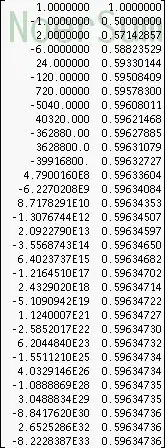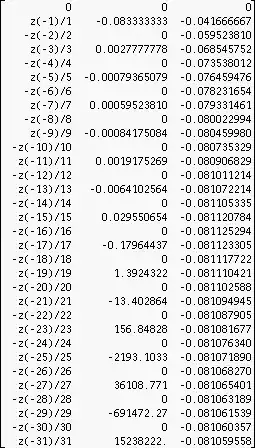This is a "fiddling" in a small project of mine with which I'm concerned from time to time for three years now. I try to focus on the core of the problem, please ask if more context is needed.
Consider the divergent series $$ \sum_{k=1}^\infty {(-1)^{k-1} \over k }\zeta(-k) \underset{\mathcal N}{=} s_1 = -0.081061466... $$ Here the symbol "$\underset{\mathcal N}{=} $" means, that I did that sum by the Noerlund-summation-method using 64 terms. The value which I expect by some other derivation which I'll explain below is $ -\zeta(0)' = 0.91893853 $ which differs exactly by 1.
More context: the coefficients at the zetas are taken just from the matrix of Stirling-numbers of the first kind, denote them simply as $s1_{r,c}$ , so the defition stems really from: $$ \sum_{r=1}^\infty s1_{r,1} \cdot {1! \over r! }\zeta(-r) \underset{\mathcal N}{=} s_1 $$
Next consider the divergent series taken from the next column in the Stirling matrix: $$ \sum_{k=1}^\infty s1_{k,2} \cdot { 2! \over k! }\zeta(-k) \underset{\mathcal N}{=} s_2 = -0.006356455... $$ The value which I expect by the other derivation is $ \zeta(0)'' = -2.00635645591... $ which differs (relatively near) by $2!$. (The difference can be made smaller by taking more terms for the Noerlund-summation)
To make things short, I'm doing the dotproduct $$ Z \cdot S1 \underset{\mathcal N}{=} Y $$ where the infinite rowvector $Z$ contains the consecutive zetas $\zeta(0),\zeta(-1),\zeta(-2), ...$ and $S1$ is the matrix containing the Stirlingnumbers first kind, scaled by factorials such that $$ S1_{r,c} = s1_{r,c} \cdot { c!\over r!} $$ getting the result-vector $Y$ which deviates from my expected result of derivatives $ \zeta(0)^{(c)}$ by factorials such that $$ Y[c]= (-1)^c \cdot (\zeta(0)^{(c)} + c!) $$
The problem is connected with that of the Ramanujan-summation of the series of like powers of logarithms: $$ \sum_{k=0}^{\infty} \log(1+k)^c \underset{\mathcal Z}{=} (-1)^c \cdot \zeta(0)^{(c)} $$ where I get (by "$\mathcal Z $" eta-regularization) the "magic constants" having the same values as I described above and which deviate by the expected values for that sums (by the signed $\zeta(0)$-derivatives) exactly the factorials. (See my earlier question in MSE but in which I had not yet that more general view with the columns of the Stirlingmatrix)
Additional remarks: the complete background can be found in this article (I'm just editing the concerning paragraphs) and was remotivated by the recent question here in MSE



